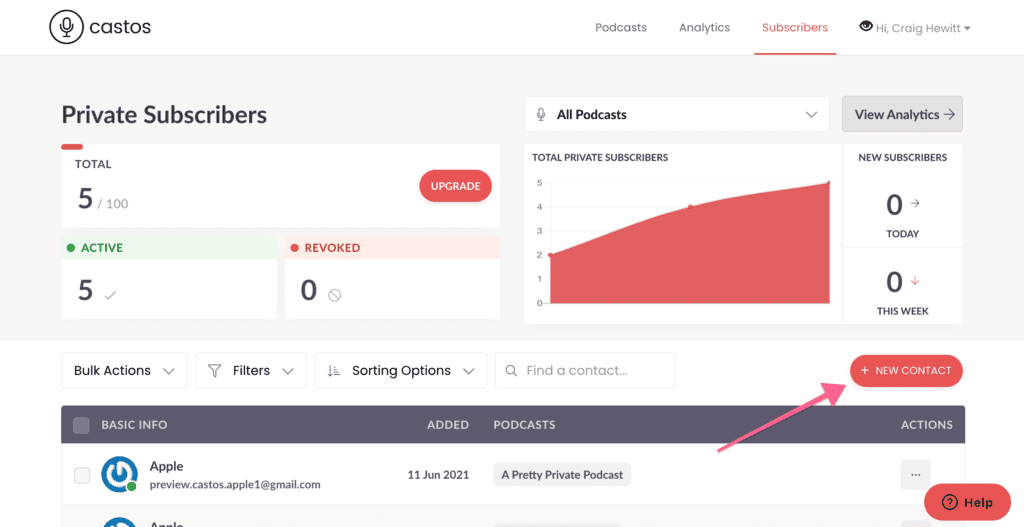The nature of education is changing. At one time, learning only took place in a classroom with rows of desks or tables and the teacher at the front scribbling on a blackboard.
Now, however, education is far more complex and we experience it in diverse forms. This variety means that educators can choose the right tools for their needs. It also means education is more accessible to everyone.
Remote learning is more popular than ever. This is partly due to the covid-19 pandemic, but also because of our growing interconnectivity. Students and teachers have a plethora of ways to communicate, transfer files, and produce content so that distance learning has become simple and effective.
In this article, we’d like to talk a little bit about remote learning and what it means for students and teachers today. Then we’ll talk about how our favorite method of communication – podcasting – fits into this new paradigm.
Interested in starting a remote learning podcast?
Castos’ mobile application provides a state-of-the-art listening experience for remote learning podcasts that is both customizable and 100% confidential. Enter your information below to learn more.
Action
Read to start your own podcast? Learn the nitty-gritty details of starting your own show in our comprehensive guide. Learn how to start a podcast.
What is Remote Learning? How Does Remote Learning Work?
Remote learning is simple: It’s when the student and the teacher aren’t in the same physical location. Instead, instructors and students communicate using a variety of technology tools. This might include video conferences, virtual assignments and tests, discussion boards, project management tools, and even podcasts.
Remote learning programs look different across all levels of education. Younger students typically have more face-time with their teachers. The teacher might host a video conference for the entire duration of the class and expect active participation.
Old students are typically given less direction. A teacher might set up a virtual classroom (such as Google Classroom or Khan Academy) to distribute assignments and resources. There may not be any direct instruction at all, instead students are expected to consume resources and complete assignments on their own time. These types of asynchronous learning models are common in workplace training.
Remote learning does not imply a great distance or a world-changing event that prevents people from meeting together (like the COVID-19 pandemic). It can be practiced by anyone for any educational purpose, even if all parties are geographically close.
For instance, an employer may use remote learning to initiate a training or development program for their team, even though everyone works on the premises. Employees could log in from their desks and work synchronously or asynchronously.
The Benefits of Remote Learning
Why should you use remote learning? Let’s go over the benefits:
Remote learning prevents interruption in education
Pandemics aren’t common, but there are plenty of interruptions that can disrupt the learning environment, such as weather, illness, scheduling conflicts, and life’s responsibilities. Remote learning can work around these events so the education never stops.
Distance learning makes education flexible
You can teach at any time and structure your class in any way. Students can engage with their school work in whatever way works best for them. Nobody has to commute anywhere, which saves time and makes people more likely to commit themselves to education. This flexibility makes it easier for students to balance their other commitments, like work, family, and other obligations.
Remote learning lets students work at their own pace
In a classroom setting, students are forced to work at the pace of the class. If a topic or task takes them longer than everyone else, they are forced to work quickly and, most likely, perform poorly. Remote learning gives students the opportunity to spend as much time as they need to complete their work and learn topics well.
Distance learning can use countless tools
Once you break away from the traditional in-person model of learning, you realize that there are a myriad of ways to recreate the learning experience remotely. World events and changing lifestyles have made these tools more popular than ever. There are plenty of education-specific tools that have grown or been released specifically for this new phase of education, as well as older tools that are evolving to keep up.
Podcasts and Remote Learning
Like we said, technology plays a big role in remote learning. There are countless ways to use tech to support the learning experience. We’re seeing podcasts play a larger role in education, specifically distance learning.
Podcasts are great at delivering lecture content. An instructor can simply record episodes of their typical lecture content without creating anything new. All the teacher has to do is deliver the podcast episode along with their slides and the student basically has access to the exact type of lecture experience they would get in a classroom.
Podcasts also create great opportunities for guest speakers or interviews. Since episodes can be recorded remotely with off-the-shelf recording software, it’s easy to convince guests to donate 30 minutes of their time to the class since there’s no need to meet physically anywhere.
Furthermore, the best educators enhance their podcast with other elements, such as sound effects and music or audio clips from other sources. For example, when an instructor references an expert, they might include a clip from that expert’s latest TED talk. These kinds of elements make learning content far more interesting.
What’s great about the podcast format is that students retain access to the lecture material forever. All of the teaching content is available on demand. If a student has a question, they can simply revisit one of your previous episodes to get clarification.
In terms of length, educational podcast episodes can be as long or as short as you like. Some educators like to record continuous, hour-long lessons. Other educators like to produce brief 10-minute lessons that are easy to consume. You have total flexibility here.
Naturally, some students will want to work ahead. Perhaps they want to get ahead of a scheduling conflict. Or maybe they just love your content. Remote learning with podcasts gives them complete flexibility over their schedule.
Private Podcasting for Distance Learning
You might be thinking, “Well, podcasting for remote learning sounds great, but I don’t want my show to be accessible to everyone.”
That’s a fair concern. If you list your podcast on Apple Podcasts, Google Podcasts, or Spotify, it will be available to anyone who uses those listening apps. Anyone could download an episode and listen free of charge without your knowledge. This is problematic if your content is confidential or if you want to charge a fee to your students.
The solution is private podcasting. A private podcast is just like a traditional podcast, except it’s only available to a specific group of people. You control who has access to your content at any time. You can grant or revoke control at any time.
How do you distribute a private podcast? You need to work with a podcast host that offers private podcasting. With Castos, you can make your podcast private in two ways:
The first method is to set a password. This creates a global RSS feed that users need to access your show. Users must enter the right credentials to access your latest episodes.
The second method is to subscribe individual listeners with their email address. Behind the scenes, Castos will send an email to the subscriber’s email address with a unique RSS feed link and buttons to subscribe to the private podcast on all listening platforms that support this feature. Your audience can simply click on their favorite podcast listening app they’ll automatically be subscribed to your private content.
Tip
Have a lot of people you want to invite to your podcast? Contact our team to arrange for us to bulk import a spreadsheet or CSV of new Private Subscribers to your account. Contact us.
Private podcast membership sites
When it comes to building a podcast for remote learning, it helps to have a home base. You’ll want to consolidate all of your educational information in one place, such as podcast episodes, notes, images, videos, and other resources.
A simple method to consolidate all of your teaching is to create a membership site where only specific users have access to members only pages. You can embed your podcast episodes onto these pages along with your other assets. Students can leave comments on these pages regarding the material so everyone can see and participate in discussions.
How to Start Podcasting for Remote Learning
Fortunately, starting a podcast for remote learning is similar to starting a podcast for any other purpose. You need a podcast host to store and publish your audio content. You’ll need to plan your episodes, and possibly invite guests to record with you. Then you’ll need to edit each episode (or outsource this task to an editing service).
One great part about using a podcast for remote learning is that you won’t need to spend much time promoting your podcast since you already have an audience of listeners. You can just focus on creating great content for your students.
To get started using a podcast for remote learning, we strongly recommend reading our guide on how to start a podcast. It tells you everything you need to know.








This is a great way to see podcasting. It switches your mindset from a random podcast to an intentional one that can be monetized later. In a way, most podcasts are educational, so why not think about each episode like a specific lecture. More structure with clear points to help the audience. Thanks for pointing this out so clearly, Dennis.